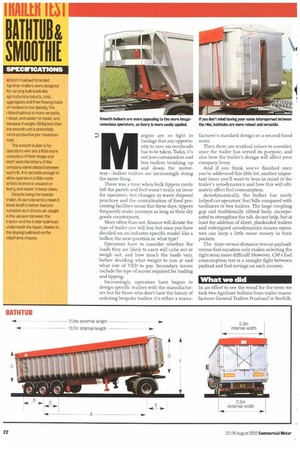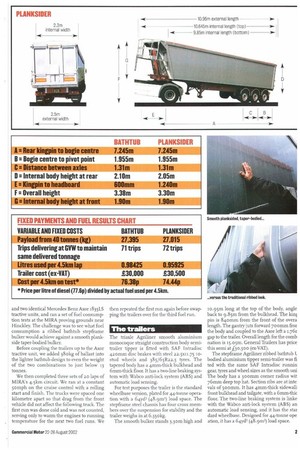argins are so tight in haulage that any opportunity to
Page 22

Page 23

Page 24

If you've noticed an error in this article please click here to report it so we can fix it.
save on overheads has to be taken. Today, it's not just c-urtainsiders and box trailers franking up and down the motorway—bulker trailers are increasingly doing the same thing.
There was a time when bulk tippers rarely left the parish and fuel wasn't really an issue for operators, but changes in waste disposal practices and the centralisation of food processing facilities mean that these days, tippers frequently make journeys as long as their dry goods counterparts.
More often than not, finance will dictate the type of trailer you will buy but once you have decided on an industry-specific model like a bulker, the next question is: what type?
Operators have to consider whether the loads they are likely to carry will cube out or weigh out, and how much the loads vary, before deciding what weight to run at and what rate of VED to pay. Secondary issues include the type of access required for loading and tipping.
Increasingly, operators have begun to design specific trailers with the manufacturers but for those who don't have the luxury of ordering bespoke trailers its either a manu facturer's standard design or a second-hand semi.
Then there are residual values to consider, once the trailer has served its purpose, and also how the trailer's design will affect your company livery.
And if you think you've finished once you've addressed this little lot, another important issue you'll want to bear in mind is the trailer's aerodynamics and how this will ultimately affect fuel consumption.
Aerodynamically, the bulker has rarely helped cut operators' fuel bills compared with tautliners or box trailers. The large coupling gap and traditionally ribbed body, incorporated to strengthen the tub, do not help, but at least the addition of sheet, planksided trailers and redesigned aerodynamics means operators can keep a little more money in their pockets.
The time-versus-distance-versus-payloadversus-fuel equation only makes selecting the right semi more difficult! However, CMs fuel consumption test is a straight fight between payload and fuel savings on each journey.
What we did
In an effort to see the wood for the trees we took two Agriliner bulkers from trailer manufacturer General Trailers Fruehauf in Norfolk,
and two identical Mercedes Benz Axor 1835LS tractive units, and ran a set of fuel consumption tests at the MIRA proving grounds near Hinckley. The challenge was to see what fuel consumption a ribbed bathtub stepframe bulker would achieve against a smooth plankside taper-bodied bulker.
Before coupling the trailers up to the Axor tractive unit, we added 380kg of ballast into the lighter bathtub design to even the weight of the two combinations to just below 13 tonnes,
We then completed three sets of 20 laps of MIRA's 4.5km circuit. We ran at a constant 50mph on the cruise control with a rolling start and finish. The trucks were spaced one kilometre apart so that drag from the front vehicle did not affect the following truck. The first run was done cold and was not counted, serving only to warm the engines to running temperature for the next two fuel runs. We
then repeated the first run again before swapping the trailers over for the third fuel run.
The trailers
The triarde Agriliner smooth aluminium monocoque straight construction body semitrailer tipper is fitted with SAF Intradisc 420MM disc brakes with steel 22.5)(11.75 rostud wheels and 38.5 /65R22.5 tyres. The tapered body has a 4mm-thick bulkhead and Gmm-thick floor, It has a two-line braking system with Wabco anti-lock system (ABS} and automatic load sensing.
For test purposes the trailer is the standard wheelbase version, plated for 44-tonne operation with a 64yd3 (48.9n-15) load space. The stepframe steel chassis has four cross members over the suspension for stability and the trailer weighs in at 6,55 okg.
The smooth bilker stands 3.30m high and ro.95m long at the top of the body, angle back to 9.85m from the bulkhead. The lcirq pin is 840mm from the front of the overa length. The gantry juts forward 7oomrn fror the body and coupled to the Axor left a 1.76r gap to the trailer. Overall length for the comb nation is 15.o5m. General Trailers has price this semi at f3o,5oo (ex-VAT).
The stepframe Agriliner ribbed bathtub L bodied aluminium tipper semi-trailer was fi ted with the same SAF Intradisc runnin gear, tyres and wheel sizes as the smooth urn The body has a 3001m corner radius wit 76mm deep top hat. Section ribs are at inte: vals of 500mm. It has 4mm-thick sidewall: front bulkhead and tailgate, with a Gmm-thk floor. The two-line braking system is linke with the Wabco anti-lock system (ABS) an automatic load sensing, and it has the star dard wheelbase. Designed for 44-tonne ope ation, it has a 64yd3 (48.9m3) load space.
Kerbweight is 6,170kg and the trailer is 3.38m high and mom long. The kingpin is set 6 oomm back from the bulkhead, leaving a 1.46m coupling gap between tractor and trailer. General Trailers has placed a f3o,000 (ex-VAT) price tag on the bathtub.
Variables
The tests were run at a combined weight of 12,985kg rather than at full GCW and both trailers were sheeted for the test. Weather conditions for track testing at MIRA were very good. The sun was out with the temperature ranging from 12-15.50C, although it was tempered a little by a south-westerly gusting at 4.18.8m/s. The wind picked up at the start of the test but dropped to its lowest point on the second fuel run before averaging 6.5m/s during the final set of laps.
Fuel results
After 270km the smooth plankside bulker proved to be the more fuel-efficient by 2.5%. The slightly heavier smooth trailer used an average of o.95925 litres per 4.5km lap. With 380kg ballast to even the weight, the ribbed bathtub used an average 0.98425 litres per lap. Each lap was completed in approximately 3.25min, with fuel readings taken from the flow meter.
CM also recorded the trip from MI RA back to General Trailers at Dereham, in Norfolk. Here the combination with the ribbed bathtub recorded 15.48mpg over the 225.8km trip, while the plankside smooth trailer clocked up
Conclusions
As an operator there are many variables to take into account when buying either of these trailers—not least the f500 difference in purchase price.
Haulage contracts can be based on weight carried or number of trips made but either way, the payload is a vital issue and the less you can fit onboard, the more likely an extra trip will be needed.
While a 2.5% difference in fuel consumption does not seem very much at first glance, if you multiply that by the number of trips you make in a year it will soon add up. The price of a litre of diesel at our local station is 77.6p; it's a simple equation.
Having said this, the ribbed bathtub is not to be ignored. It is /50o cheaper to buy, more versatile and robust, and with a 27,395kg payload offers 380kg more carrying capacity.
This equates to a 1.4% payload advantage for the ribbed and inevitably, you'll be running at maximum payload if you want to maximise productivity. If you work out the difference, you'll find this means saving one trip in 71.
• by Kevin Swallow
















































































































































